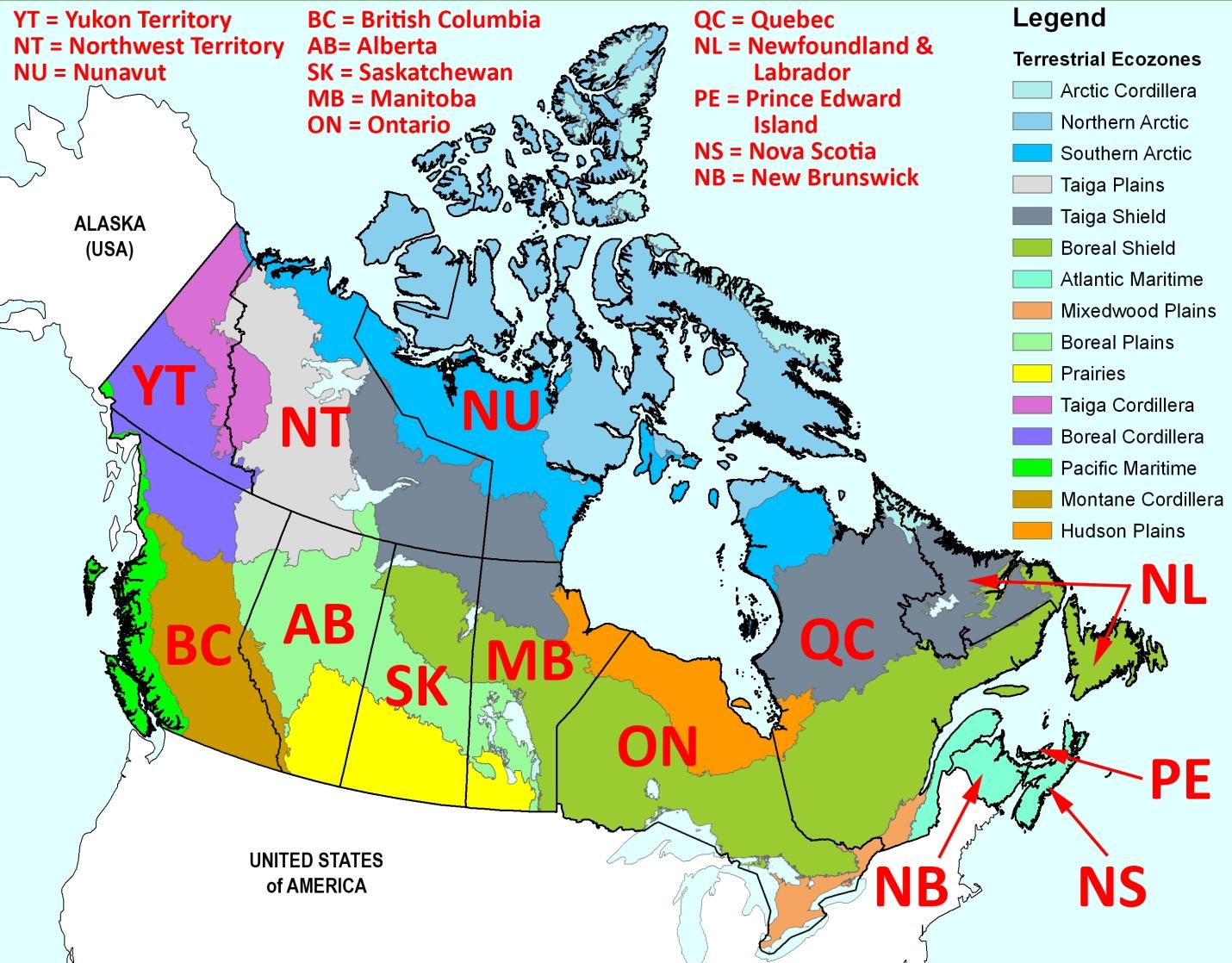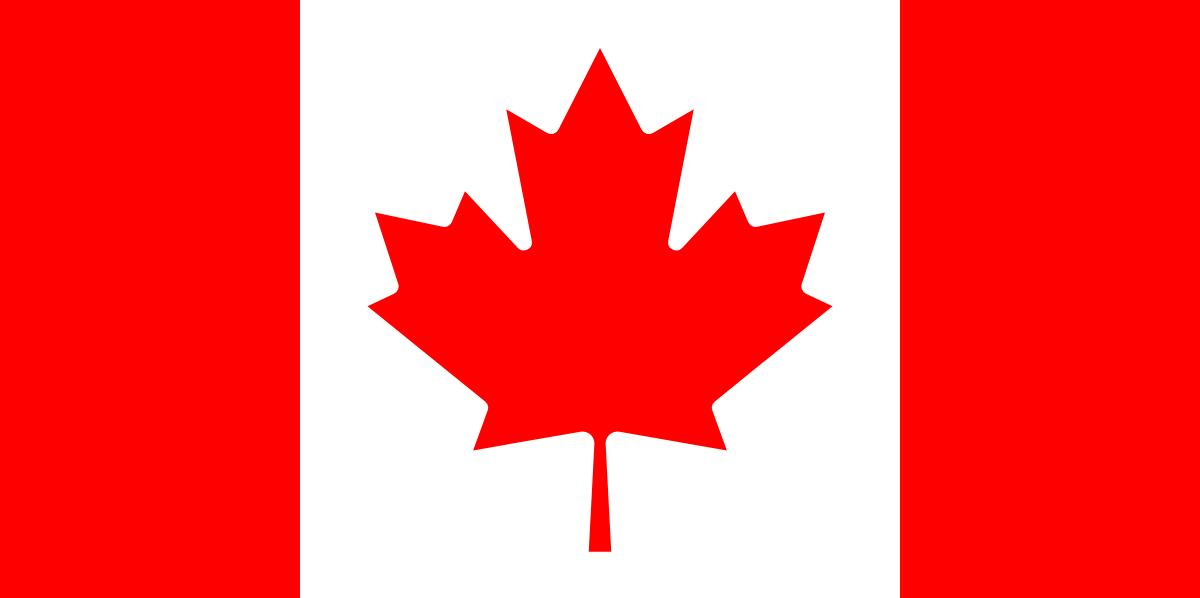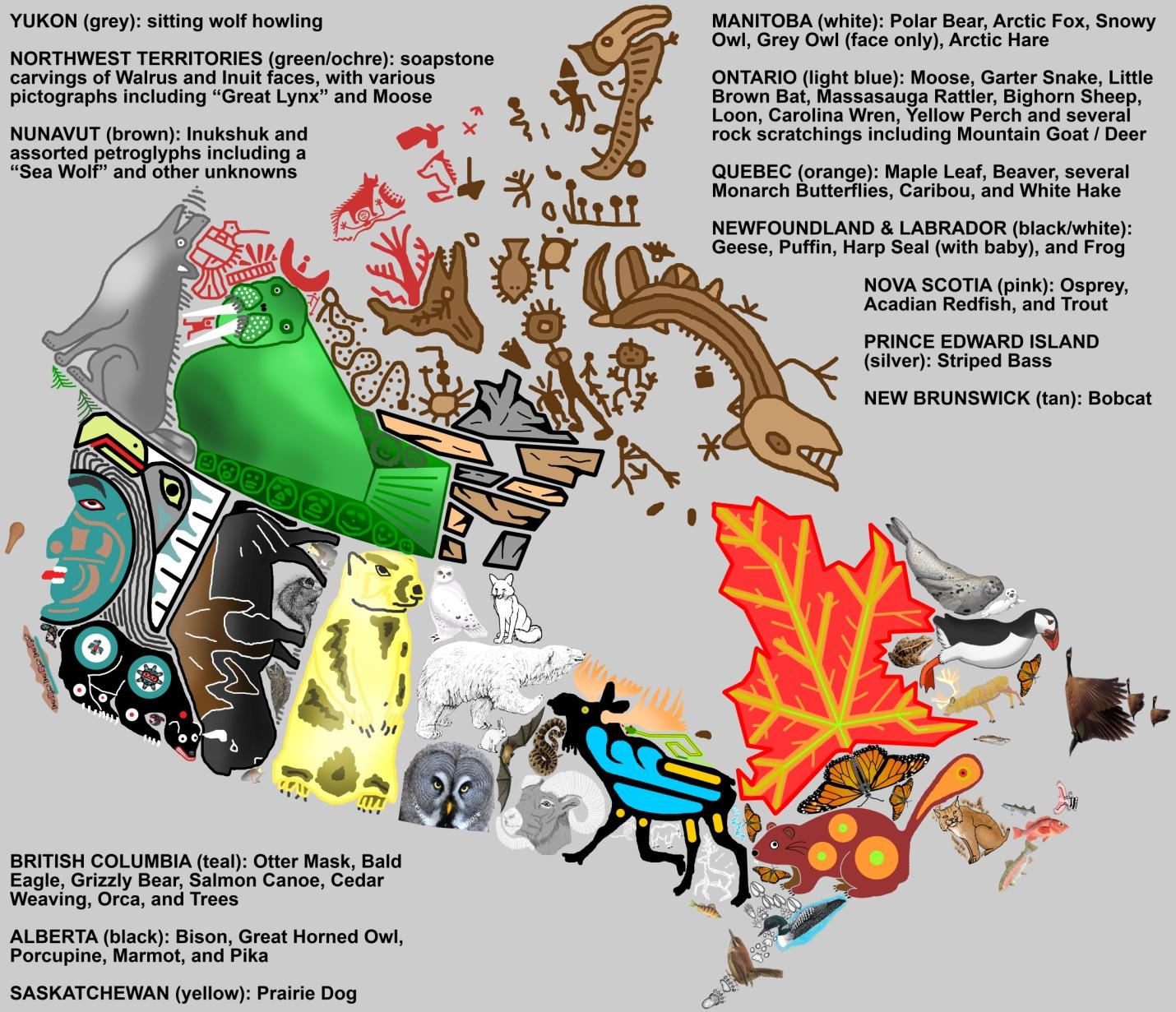1 Reintroducing Canada!
Simon Priest and Stephen D. Ritchie
Canada is a vast country in North America and indeed the world. However, relevant to outdoor learning in Canada (OLiC), it is important to reintroduce several other distinct socio-political characteristics. Despite the vast geography, the population of 39 million (Statistics Canada, 2022a) is relatively low compared to many other nations around the world, and the vast majority of this population lives in close proximity to the southern border with our influential neighbour, the United States (aka America). As a progressive social democracy, Canada has a distributed power and governance structure with the 10 provinces and three territories responsible for education, health, social services, and resource management. For example, see the differences across education at https://www.cmec.ca/299/Education_in_Canada__An_Overview.html.
French and English are the official languages and cultures in Canada, although there are also seven million (18%) other immigrant people, who speak other languages and have distinct cultural practices (EduCanada, 2022). The 1.8 million (5%) Indigenous people in Canada include First Nations, Inuit, and Métis people (Statistics Canada, 2022b), and these populations represent hundreds of communities, dozens of distinct languages, and unique histories. These people live in geographically dispersed land territories from coast to coast, including in the far north (Government of Canada, 2022a). Thus, OLiC is as diverse as the socio-political characteristics across the nation.
However, despite being overshadowed and strongly influenced by our nearest neighbour, America, Canada does have its own unique culture and zeitgeist (Government of Canada, 2021). Canadians are heavily pressured by British, French, and American interests as indicated by our mixed spelling (colour/color, theatre/theater, or grey/gray) and mixed measurements (outside temperatures in Celsius/cooking temperatures in Fahrenheit, food weights in kilograms/body weights in pounds, and lengths in metres/heights in feet). To begin, we would like to reintroduce (or remind you of) some additional proud Canadian facts, current at the time of publication: 2023. Perhaps you already knew…
- Canada is the world’s second-largest country by total area (9,984,670 km2) after Russia, but is sparsely inhabited with a population of about 38 million people (4 per km2) and 75% of these are concentrated along its southern land border within 100 km of the USA (World Atlas, 2021).
- While over 80% of Canada’s land areas are uninhabited, over 27% of Canada’s land mass (2,728,800 km2) is located north of the tree line (Statistics Canada, n.d.).
- Canada has some of the planet’s most extensive wilderness (undisturbed by humans passing through it) and most diverse natural and fragile ecosystems including arctic tundra, subarctic taiga, deciduous Boreal Shield woodlands, Rocky Mountains or Montane Cordillera, mixed woods, coniferous rainforest, plains/grassland prairies, wetlands, lakes, and marine ecozones (Ecological Land Classification, 2017).
- Canada has the world’s longest coastline (243,042 km), which is one-third of the world’s total and spans three oceans. Shaped by a geological history of ice age glaciations, it is composed of the abundant fiords of the Pacific, the numerous islands of the Arctic Archipelago, and the plentiful inlets of the Atlantic. These contribute to its enormous length (World Factbook, 2021).
- Given its position in the northern hemisphere, Canada tends to be a colder country than most, with plenty of snow, earning it the nickname of the “Great White North” (World Atlas, n.d.).
- Canada has received Guinness World Records (2019) for the biggest snow maze (St. Adolphe, Manitoba) and the longest winter road. At 752 km long, the Wapusk Trail is a road constructed each January atop snow and ice to reach isolated settlements in northern Manitoba.

- Canada has the world’s longest land border (8,890 km), an “international boundary” with the USA, that it is “unprotected” and not militarized or defended (Statistics Canada, n.d.).
- Canada experiences the world’s fastest saltwater rapids (30 km/hr) at Nakwakto, BC, and its highest tides (average 16 m change) at the Bay of Fundy, NB/NS (Statistics Canada, n.d.).
- Canada’s largest saltwater island and the world’s fifth largest is Baffin in the Arctic, but Manitoulin in Lake Huron is the world’s largest freshwater island (Statistics Canada, n.d.).
- Canada hosts 25% of the Earth’s wetlands and holds 20% of the globe’s freshwater in more lakes (60%) than all other nations combined (Messager et al., 2016).
- Canada supplies 85% of the global demand for maple syrup with 70% of this coming from Quebec (Agriculture and Agri-food Canada, 2011). The Great Canadian Maple Syrup Heist, 2011-2012, saw the gradual siphoning theft of almost 3,000 tonnes from storage in Quebec valued at almost $19 million, the greatest cost of anything stolen in Canada to date (History 101, 2022).
- The red maple leaf design on the country’s flag, first raised in 1965, had been a national symbol indicative of the Sugar Maple and other similar trees from before the 1867 Confederation of Canada (Government of Canada, n.d.).

- Receiving official royal assent in 1975, the Beaver is Canada’s iconic national animal dating back to the 1530s fur trade, which almost wiped them out. With orange buckteeth that continuously grow, they are one of the few animals, other than humans, that modify their habitat. They chew and cut saplings to build mud dams and digest the wood chips (Canadian Geographic, 2019).
- Canadians are known as a peace-loving people with an international reputation for their politeness. Sorry, but at least one province passed key legislation preventing parties from using an apology as a statement of fault or liability in court (BC Ombudsperson, 2006).
- Although Canadians love donuts more than any other nation (over a billion consumed annually), Poutine (a combination of french fries and cheese curds melted in gravy) is a uniquely Canadian dish from Quebec (la Banquise, n.d.).
- Canadians like to skate and more Canadians can skate than swim. Canada has the longest river skating (11 km) at the Forks in Winnipeg, Manitoba, and the largest manicured skating area (0.2 km2) on the Rideau Canal in the capital city of Ottawa, Ontario (Guinness World Records, 2019).
- While ice hockey is clearly the most popular sport in the country, and the official winter sport, Canada’s official national and summer sport is lacrosse, first observed by Europeans in the 1630s being played by large teams of Indigenous Algonquins in Quebec (Lacrosse Canada, 1995).
- Crossing the country, the Trans-Canada Highway #1 (7821 km) and the Canadian Great Trail (an outdoor network stretching 28,000 km) are the longest in the world (Trans Canada Trail, n.d.).
- Schitt’s Creek, a TV comedy created by Canadians (father and son team, Dan and Eugene Levy) and filmed in Canada with all Canadian actors (except for one), won seven Primetime Awards and nine Emmys in 2020 to sweep the comedy categories (Bahr, 2020).
- The Canadian expression of “eh” at the end of a full or partial sentence is a real word defined in several top dictionaries and Canada is actually spelt: C-eh-N-eh-D-eh!
- Canada has an official government services toll-free phone number: 1-800-O CANADA!
- Santa Claus receives letters at the North Pole in Canada with the postal code H0H 0H0.
- In 2018, cannabis was legalized in Canada and was the second country to do so, after Uruguay (Government of Canada, 2022b).
- Canada is the second most educated country in the world after South Korea, with 99% literacy and 63% of Canadians earning a higher education/tertiary degree (OECD, 2021).
- The international Organization for Economic Co-operation and Development (OECD, 2021) recently named Canada as the best country in the world for acceptance of minorities.
- Canada was ranked highest in North America and Europe for entrepreneurial activity, ambition, and new start-up businesses, as well as being in the strongest position to economically recover from the recent pandemic (Global Entrepreneurship Monitor, 2021; OECD, 2021; Desai, 2016). The nation’s culture of innovation has been attributed to a strong ethnic diversity of immigrants willing to take risks (Rideau Hall Foundation, 2019).
- Canada often receives top billing as the best place to live with the highest quality of life (US News & World Report, 2021). So far, Canadians have been living the American Dream, but with universal healthcare and without so much gun violence or innate white supremacy.
- Canadian discoveries, inventions, and creations include: the telephone (Alexander Graham Bell in Ontario and Nova Scotia), Insulin (Frederick Banting and Charles Best in Ontario), the discovery of the stem cell (James Till and Ernest McCulloch in Ontario), half of Superman (Joe Shuster in the US), the game of Trivial Pursuit (Scott Abbot and Chris Haney in Quebec), IMAX projection (Graeme Ferguson, Roman Kroitor and Robert Kerr in Quebec), the space shuttle’s remote Canadarm (scientists and engineers at SPAR in Ontario), and, of course, the snowblower (Arthur Sicard in Quebec), snowmobile (Joseph-Armand Bombardier in Quebec), and Hawaiian pizza (Sam Panopoulos in Ontario).
- Canadians also invented the sports of hockey, basketball (James Naismith), football (at McGill University in 1874), and the baseball glove (Arthur Albert “Foxy” Irwin) for “bassball” first played in Britain, circa 1740 (CBC Sports, 2017).
- Canadians enjoy poking fun at Americans and pointing out the celebrities who are Canadian.
With the size of the country, its long coastline, bountiful freshwater lakes, sparse population, and rich wilderness, one can easily see how Indigenous Peoples developed unique modes of travel including the canoe, the kayak, and the snowshoe. These uniquely Canadian methods of travel have figured prominently in the evolution of Canadian outdoor learning and have been adopted by several nations, where the word “Canadian” often precedes canoe, kayak, or snowshoe to distinguish it from local variations. This Indigenous contribution to Canadiana is well documented (Newhouse et al., 2005).

This final fact makes Canada’s treatment of Indigenous people that much more shameful, especially with regard to their health and colonization history (McCallum, 2017). Like many nations, Canada apologized for lasting imperial oppression and struck a Truth and Reconciliation Commission to address the past, but failed to account for previous wrongs by not openly allowing Indigenous self-determination and not returning access to their lands (Corntassel & Holder, 2008).
- The Indigenous population is the fastest growing population in Canada, which makes it also the youngest, with nearly half under the age of 25 (Statistics Canada, 2022b).
- In Canada, there are over 70 Indigenous languages spoken across more than 600 First Nations and 50 Inuit communities, and a plurality of groups representing the Métis people (Statistics Canada, 2022a).
- First Nations governance includes Chiefs and Councils within each First Nation, tribal councils representing several First Nations, provincial and territorial organizations, and the Assembly of First Nations representing all First Nation people in Canada (Government of Canada, 2022).
- In the Inuit language of Inuktitut, the word Inuit means “the people”, and they live in Inuit Nunangat, which means “the place where Inuit live” and it includes Inuvialuit (Northwest Territories), Nunavik (Northern Quebec), Nunatsiavut (Labrador), and Nunavut (Government of Canada, 2022).
- Métis people are defined by more than their mixed ancestry (Indigenous and Francophone); they have their own language (Michif), culture, claims to land, and a rich history in Canada (Canadian Encyclopedia, 2023).
From an Indigenous perspective, outdoor learning is often referred to as land-based learning, or simply connecting with the land. Indigenous people in Canada are known for their deep understanding and connection to the land, their passionate stewardship of natural resources, and their leadership in conservation and environmental activism. Thus, the Indigenous knowledges and teachings related to the land and all of creation are an incredibly rich resource for outdoor learning practitioners across Canada.
Native Land Digital was created by Canadians in 2018 to provide an online centralized resource (https://native-land.ca/) for identifying international Indigenous territories. Thus, this resource can be used by outdoor learning practitioners to identify the traditional territories, languages, and treaties associated with the region they are practicing outdoor learning anywhere across the country and around the world.
Outdoor learning has a unique opportunity to heal intergenerational trauma and contribute to further reconciliation through its inherent process of democratizing social injustice, challenging systems of privilege, and growing citizens who will solve the world’s future big problems (Priest & Asfeldt, 2022; Priest & Henderson, 2021).
References
Agriculture and Agri-food Canada. (2011). Canadian Maple Syrup. http://www5.agr.gc.ca/resources/prod/Internet-Internet/MISB-DGSIM/CB-MC/PDF/4689-eng.pdf
Barh, S. (2020, September 20). ‘Schitt’s Creek’ sets an Emmy record. New York Times. https://www.nytimes.com/2020/09/20/arts/television/emmys-schitts-creek.html
BC Ombudsperson. (2006). Quick tips of apologies. https://bcombudsperson.ca/assets/media/Quick-Tips-Apology.pdf
Canadian Encyclopedia. (2023). Métis (Plain Summary). https://www.thecanadianencyclopedia.ca/en/article/metis-plain-language-summary
Canadian Geographic. (2019). Animal facts: Beaver. https://canadiangeographic.ca/articles/animal-facts-beaver/
CBC Sports. (2017, June 15). How Canada invented “American” football, baseball, basketball and hockey. https://www.cbc.ca/sportslongform/entry/how-canada-invented-american-football-baseball-basketball-and-hockey
Corntassel, J. & Holder, C. (2008). Who’s sorry now? Government apologies, Truth commissions, and Indigenous self-determination in Australia, Canada, Guatemala, and Peru. Human Rights Review, 9, 465–489.
Desai, N. (2016, February 26). Opinion: Myth of Canadian complacency has permeated our highest echelons. https://www.theglobeandmail.com/report-on-business/rob-commentary/myth-of-canadian-complacency-has-permeated-our-highest-echelons/article28915265/
Ecological land classification. (2017). https://www.statcan.gc.ca/eng/subjects/standard/environment/elc/elc2017
EduCanada. (2022). Canada’s languages. https://www.educanada.ca/study-plan-etudes/during-pendant/languages-langues.aspx?lang=eng
Global Entrepreneurship Monitor. (2021). 2020/2021 global report. https://www.gemconsortium.org/report
Government of Canada. (2021). Canada-United States relations. https://www.international.gc.ca/country-pays/us-eu/relations.aspx
Government of Canada. (2022a). Indigenous peoples and communities. https://www.rcaanc-cirnac.gc.ca/eng/1100100013785/1529102490303
Government of Canada. (2022b). What you need to know about cannabis. https://www.canada.ca/en/services/health/campaigns/cannabis/canadians.html
Government of Canada. (n.d.). The history of the national flag of Canada. https://www.canada.ca/en/canadian-heritage/services/flag-canada-history.html
Guinness World Records. (2019). https://www.guinnessworldrecords.com/
History 101. (2022, May 11). The great Canadian maple syrup heist. https://www.history101.com/the-great-canadian-maple-syrup-heist/
la Banquise. (n.d.). History of Poutine. https://labanquise.com/en/poutine-history.php
Lacrosse Canada. (1995). History of lacrosse. https://www.lacrosse.ca/content/History-of-Lacrosse
McCallum, M.J.L. (2017). Starvation, experimentation, segregation, and trauma: Words for reading Indigenous health history. The Canadian Historical Review, 98(1), 96-113.
Messager, M., Lehner, B., Grill, G., Nevada, I. & Schmitt, O. (2016). Estimating the volume and age of water stored in global lakes using a geo-statistical approach. Nature Communications, 7, 13603.
Newhouse, D.R., Voyageur, C.J., & Beavon, D. (2005). Hidden in plain sight: Contributions of Aboriginal peoples to Canadian identity and culture. University of Toronto Press.
Organization for Economic Co-operation and Development. (2021). https://data.oecd.org/canada.htm
Priest, S., & Asfeldt, M. (2022). The history of outdoor learning in Canada. The International Journal of the History of Sport, 39(5), 489-509.
Priest, S., & Henderson, B. (2021). Why is outdoor learning not a bigger part of Canadian education? Pathways: The Ontario Journal of Outdoor Education, 34(1), 4–18.
Rideau Hall Foundation. (2019). Canada’s culture of innovation index. https://rhf-frh.ca/innovation-index/
Statistics Canada. (2022a). Canada’s population estimates, third quarter 2022. https://www150.statcan.gc.ca/n1/daily-quotidien/221221/dq221221f-eng.htm
Statistics Canada. (2022b). Indigenous population continues to grow and is much younger than the non-Indigenous population, although the pace of growth has slowed. https://www150.statcan.gc.ca/n1/daily-quotidien/220921/dq220921a-eng.htm
Statistics Canada. (n.d.). Canada yearbooks (Archived). https://www150.statcan.gc.ca/n1/pub/11-402-x/2012000/chap/geo/geo-eng.htm
Trans Canada Trail. (n.d.). Welcome to the Trans Canada Trail. https://tctrail.ca/
US News & World Report. (2021). https://www.usnews.com/news/best-countries/rankings-index
World Atlas. (2021, February 25). https://www.worldatlas.com/maps/canada
World Atlas. (n.d.). https://www.worldatlas.com/articles/which-country-is-known-as-the-great-white-north.html
World Factbook. (2021). https://www.cia.gov/the-world-factbook/field/coastline/

